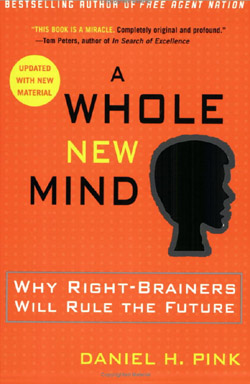Daniel Pink’s Why Right-brainers Will Rule the Future introduces a new way of achieving professional and personal success in the modern world: tap into both sides of your brain.
The Big Ideas!
• Although we sometimes view “right-brained” (or creative) and “left-brained” (or logical) as being opposites, the ideal way to function in today’s world is whole-brained. The Industrial Age and the Information Age were heavily focused on left-brain skills, but these resources are no longer enough to meet our needs. It’s time to provide balance by developing right-brained ways of interacting with the world.
• In this new age, we will place more value on experiences that are “high concept” and “high touch.” High concept refers to recognizing patterns, creating beauty, telling stories, and combining dissimilar elements into new forms. High touch relates to empathy, joy, subtle human relationships, and finding one’s purpose.
• We can cultivate six senses that are based in the right brain: design, story, symphony, empathy, play, and meaning.
Neutrino’s Nutshell
In spite of the technological changes and developments we have experienced, creativity and innovation will triumph over logic and tradition. The ability to “think outside the box” has become a valued quality on a professional and personal level. It serves as a way for us to adapt to the constant ups and downs of life, and make the best of any situation.
Two factors contribute to the shift from logical to creative and logical: much of the logic-based white collar work in the United States (such as software development) has been outsourced to Asian countries, where it is cheaper to produce. Second is abundance—the sheer magnitude of variability that is available in developed nations today. With so much choice available to the average consumer, there is a growing demand for meaning and beauty, in addition to functionality.
The six senses proposed in this book are gateways to a more balanced “whole brain” experience in the world:
- Design (versus function): This concept includes everything from the color of your clothes to the structure of the building you live in. Design goes beyond simple usefulness by incorporating visual pleasure and personal significance.
- Story (versus argument): Human beings are drawn to information that is conveyed in the form of a narrative, which is created through context and emotional impact.
- Symphony (versus focus): It’s about synthesizing separate pieces of information and noticing connections that are not obvious. The key here is relating one thing to another in ways that are not necessarily logical.
- Empathy (versus logic): This quality allows us to perceive how another person’s experience might feel to him or her. It’s one area in which humans excel where computers fail.
- Play (versus seriousness): Humor, game-playing, and joyfulness are three ways to access a deeper experience of being human—and we might even find ourselves becoming more productive or capable as a result.
- Meaning (versus accumulation): Having reached a pinnacle in which material goods are abundantly available, people in the developed world now find themselves searching for a sense of purpose and significance.
Quotables
“The future belongs to a very different kind of person with a very different kind of mind—creators and empathizers, pattern recognizers, and meaning makers. These people—artists, inventors, designers, storytellers, caregivers, consolers, big picture thinkers—will now reap society’s richest rewards and share its greatest joys.”
IMEO (In My Eudaimonian Opinion)
People who consider themselves creative or unconventional—or who have family members that fit this description—will love Daniel Pink’s book. The premise that a balanced whole-brained approach will serve us better than the same old left-brain logic is in keeping with recent findings in neuroscience. This book weaves together socioeconomic and technological analysis (the big picture) with concrete advice on how to change your individual paradigm. Its overall structure is a model for whole-brained thinking that practices what it preaches, featuring “high concept” pattern recognition and “high touch” meaning-making.
Take Action, humanoid!
Here are a few suggestions of simple ways to incorporate the six senses into your own life.
- Design: Make an effort to notice the design of everyday objects. Keep a notebook with your observations (which could be sketches, rants, questions, or any other format). Pick one object that you think is poorly designed and consider how it could be better.
- Story: Choose a family photo and tell the story of what you see in the picture. Now, tell the back story—the part of the tale that isn’t obvious from looking at the photo.
- Symphony: Do a little link-hopping to explore how unusual connections can emerge when you let serendipity lead the way. Start with one word or topic typed into a search engine, and click on one of the resulting links. Then click on one link on the new page. Do this eight times. Now, consider what surprising things you learned along the way, looking for any patterns that might have emerged.
- Empathy: Use the human tendency to eavesdrop as a tool to develop your ability to empathize with others. The next time that you find yourself listening in on someone else’s conversation, take the opportunity to imagine what one of the people in the exchange might be thinking or feeling.
- Play: Enjoy an outing to your local children’s museum. Explore the interactive exhibits. Absorb the curious and playful nature of the kids who are with you or nearby. How does this attitude change your way of perceiving the world?
- Meaning: Establish a daily gratitude routine. Each day at the same time—such as with your morning coffee or when you’re going to bed—pause and reflect on one thing that makes you feel grateful. Try to choose a different thing every day.
The Deets
A Whole New Mind: Why Right-Brainers Will Rule the Future
Author: Daniel H. Pink
Publication date: 2005 (275 pages)
